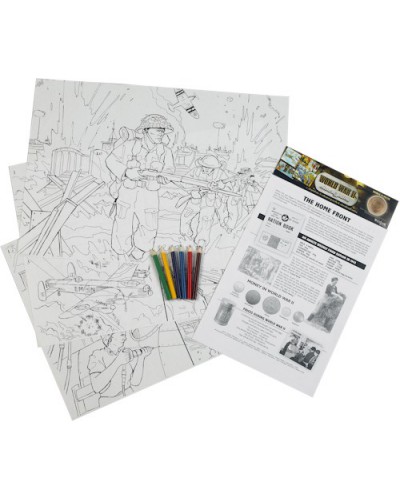Product Description: The World War II Colouring Posters consists of four A3 size colouring sheets, six colouring pencils and a World War II factsheet. The colouring posters include an image of a Battle of Britain scene, a D-Day scene, a card depicting four images of the Home Front and a card depicting four images consisting of a Royal Navy ship, British army soldiers, a Bomber Command Lancaster and Winston Churchill. The factsheet explains about World War II, the Home Front, money in World War II and there is also a crossword to complete. There is a colourful header card that has pictures showing how the posters could be coloured in and information on a George VI coin, the France and Germany Star and D-Day. All are held in a clear cellophane bag.
Information: World War II, or the Second World War was a global military conflict which involved a majority of the world’s nations, including all of the great powers, organised into two opposing military alliances: the Allies and the Axis. The war involved the mobilisation of over 100 million military personnel, making it the most widespread war in history fought all over the world. In a state of “total war”, the major participants placed their entire economic, industrial and scientific capabilities at the service of the war effort.
The war started on September 1, 1939, with the German invasion of Poland and subsequent declaration of war on Germany by most of the countries in the British Empire and Commonwealth, and by France. Adolf Hitler had organised the seaborne invasion of Britain (Operation Sealion). This invasion depended on the German Air Force having control over the skies. Between the 10 July to 31 October 1940 the Royal Air Force (RAF) defeated the German Luftwaffe in an action referred to as ‘The Battle of Britain’ and the invasion was cancelled.
Many countries joined the war later after the German invasion of the Soviet Union (Operation Barbarossa) and the attacks on Pearl Harbour and British and Dutch colonies in Southeast Asia.
On the 8th May 1945 (Victory in Europe, VE Day) the war ended in a victory for the Allies. The United States dropped atomic bombs on the Japanese cities of Hiroshima and Nagasaki in early August. On August 15, 1945 Japan surrendered, ending the war with the formal surrender ceremony performed in Tokyo Bay, aboard the battleship U.S.S. Missouri on September 2, 1945.
When the war began in September 1939 the government knew that large cities would be the target for German bombs and that casualties would be high. Evacuation was introduced to move school children, teachers, mothers with children under the age of five and disabled people out of the cities to the countryside where there was little risk of bombing raids.
Britain had always imported food and other goods from overseas and at the start of the war most goods were transported to Britain by ship. The Germans were targeting these ships which meant imported goods were in short supply. Food rationing began with sugar, butter, bacon and later with tea (the most popular drink in Britain), milk and clothing. Vegetables were not rationed but were often in short supply.
As more men were called up to serve in the forces, women were called upon to take over their jobs. Women worked in factories producing aircraft, ammunition, weapons and other goods needed for the war effort. Women also worked on farms and were known as 'Land Girls'.
The Home Guard was formed in 1940 when there was a real risk that Germany might invade Britain. The men that served in the Home Guard were all volunteers and were mostly those that were too old (over the age of 40) or too young (under the age of 18) to serve. They became known as 'Dad’s Army'.
Tags: World War II, Educational, Colouring, Posters

